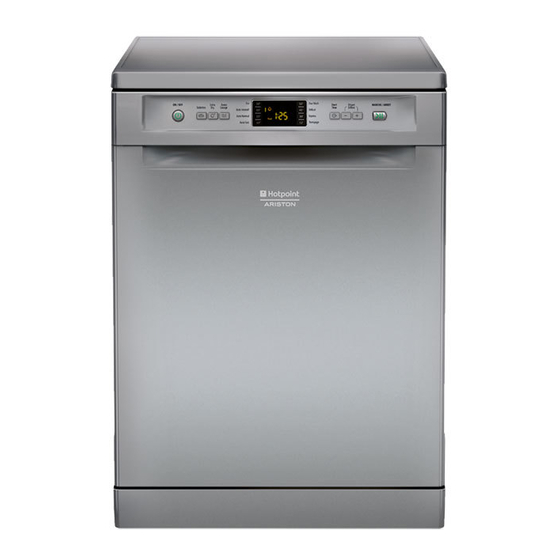Ariston LFF 8M132 Manuel d'utilisation - Page 3
Parcourez en ligne ou téléchargez le pdf Manuel d'utilisation pour {nom_de_la_catégorie} Ariston LFF 8M132. Ariston LFF 8M132 16 pages.

Precautions and advice
This appliance was designed and
manufactured in compliance with international
safety standards The following information
has been provided for safety reasons and
should therefore be read carefully.
Keep this instruction manual in a safe place
for future reference. If the appliance is sold,
given away or moved, please ensure the
manual is kept with the machine.
Please read these instructions carefully: they
contain important information on installation,
use and safety.
This appliance is designed for domestic use
or similar applications, for example:
- staff kitchen areas in shops, offices and
other work environments;
- farmhouses;
- use by guests in hotels, motels and other
residential settings;
- bed & breakfasts.
General safety
• The appliance should not be operated by
people (including children) with reduced
physical, sensory or mental capacities,
or by inexperienced people who are not
familiar with the product, unless supervision
or instructions on how to use it are provided
by someone who assumes responsibility for
their safety.
• An adult must supervise children at all
times to prevent them from playing with the
appliance.
• The appliance was designed for domestic
use inside the home and is not intended for
commercial or industrial use.
• The appliance must be used by adults only
to wash domestic crockery in accordance
with the instructions in this manual.
• The appliance must not be installed
outdoors, even in covered areas. It is
extremely dangerous to leave the machine
exposed to rain and storms.
• Do not touch the appliance when barefoot.
• When unplugging the appliance always pull
the plug from the mains socket. Do not pull
on the cable.
• The water supply tap must be shut off
and the plug should be removed from
the electrical socket before cleaning or
maintaining the appliance.
• If the appliance breaks down, do not under
any circumstances touch the internal parts
in an attempt to perform the repair work
yourself.
• Do not lean or sit on the open door of the
appliance: this may cause the appliance to
overturn.
• The door should not be left open as it may
create a dangerous obstacle.
• Some dishwasher detergents are strongly
alkaline. They can be extremely dangerous
if swallowed. Avoid contact with the skin
and eyes and keep children away from the
dishwasher when the door is open. Check
that the detergent receptacle is empty after
completion of the wash cycle.
• The packaging material should not be used
as a toy for children.
Disposal
• Disposal of packaging material: observe
local legislation so that the packaging may
be reused.
• The European Directive 2012/19/EU
relating to Waste Electrical and Electronic
Equipment (WEEE) states that household
appliances should not be disposed of
using the normal solid urban waste cycle.
Exhausted appliances should be collected
separately in order to optimise the re-using
and recycling rate of the materials inside
the machine, while preventing potential
damage to the environment and public
health. The crossed-out dustbin symbol
is marked on all products to remind the
owners of their obligations regarding
separated waste collection.
For further information relating to the correct
disposal of household appliances, owners
may contact the relevant public authority or
the local appliance dealer.
Saving energy and respecting the
environment
Saving water and energy
• Only begin a wash cycle when the
dishwasher is full. While waiting for the
dishwasher to be filled, prevent unpleasant
odours using the Soak cycle
cycles)
.
• Select a wash cycle that is suited to the
type of crockery and to the soil level of the
crockery using the Table of wash cycles:
- for dishes with a normal soil level use the
Eco wash cycle, which ensures low energy/
water consumption levels.
*
Only available in selected models.
EN
(see Wash
3
